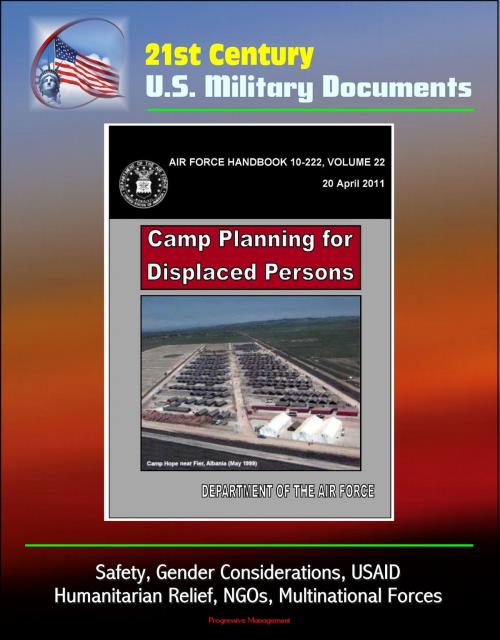21st Century U.S. Military Documents: Camp Planning for Displaced Persons (Air Force Handbook 10-222) - Safety, Gender Considerations, USAID, Humanitarian Relief, NGOs, Multinational Forces
Nonfiction, History, Military, United States, Social & Cultural Studies, Social Science| Author: | Progressive Management | ISBN: | 9781301710805 |
| Publisher: | Progressive Management | Publication: | October 9, 2013 |
| Imprint: | Smashwords Edition | Language: | English |
| Author: | Progressive Management |
| ISBN: | 9781301710805 |
| Publisher: | Progressive Management |
| Publication: | October 9, 2013 |
| Imprint: | Smashwords Edition |
| Language: | English |
Camp construction for displaced persons (DPs) falls within military Foreign Humanitarian Assistance (FHA) operations. The tactics, techniques, and procedures (TTP) associated with FHA throughout this handbook can be directly applied to displaced persons camp planning and construction. FHA consists of Department of Defense (DOD) activities, normally in support of the United States Agency for International Development (USAID) or Department of State (DOS), conducted outside the United States, its territories, and possessions to relieve or reduce human suffering, disease, hunger, or privation. FHA is conducted to relieve or reduce the results of natural or man-made disasters or endemic conditions that might present a serious threat to life or that can result in great damage to or loss of property.
FHA provided by United States (US) forces is limited in scope and duration. The foreign assistance provided is designed to supplement or complement the efforts of the host nation (HN) civil authorities or agencies that may have the primary responsibility for providing FHA. Although US military forces are primarily designed and structured to defend and protect United States national interests, they may be readily adapted to FHA requirements. Military organization, structure, and readiness enable commanders (CDRs) to rapidly and effectively respond when time is of the essence.
Chapter 1 * INTRODUCTION * 1.1. Overview * 1.2. Roles and Responsibilities * 1.3. US Military Role in FHA * 1.4. Dislocated Civilian Support Missions * 1.5. Operational Contexts * 1.6. Historical Examples * 1.7. Assumptions * 1.8. Scope * 1.9. Conclusion * Chapter 2 * ORGANIZATIONAL STRUCTURE * 2.1. Overview * 2.2. Joint Task Force * 2.3. Engineer Staff Organization * 2.5. Humanitarian Assistance Coordination Center (HACC) * 2.6. Civil-Military Operations Center (CMOC) * 2.7. Private Contractor Support * 2.8. Final Thoughts * Chapter 3 * COORDINATION * 3.1. Introduction * 3.2. Unified Action * 3.3. HACC * 3.4. CMOC * 3.5. HOC * 3.6. Cross-functional Collaboration * 3.7. NGOs, IGOs, and Private Sector Partners * Chapter 4 * PLANNING * 4.1. Introduction * 4.2. Contingency Planning * 4.3. Crisis action planning (CAP) * 4.4. Operational Environment * 4.5. Mission Analysis * 4.6. Concept of Operations * 4.7. Force Planning * 4.8. Predeployment Planning * 4.9. Deployment Planning * 4.10. Functional Planning * 4.11. Hints for Plan Development * Chapter 5 * SITE SELECTION CRITERIA * 5.1. Introduction * 5.2. Site Survey Team Composition * 5.3. Description of Key Site Survey Team Members * 5.4. Minimum Site Visit Requirements * 5.5. Site Selection Criteria * 5.6. Site Selection Methodology * Chapter 6 * CAMP LAYOUT * 6.1. Introduction * 6.2. Camp Layout * 6.3. Environmental Considerations * 6.4. Gender Considerations * 6.5. General Site Planning Considerations and Recommendations * 6.6. Specific Infrastructure * 6.7. Fire Breaks * 6.8. Administrative and Communal Services * Chapter 7 * SAFETY * 7.1. Purpose * 7.2. Integrating ORM into Contingency Operations * 7.3. Watch for Stress * 7.4. Notification and Warning System * 7.5. Electrical Services * 7.6. Water Distribution * 7.7. Tent Heaters * 7.8. Office and Billeting Tents * 7.9. Fire Prevention * 7.10. Vehicle Safety * 7.11. Handling Material and Material Handling Equipment (MHE) * 7.12. Communications * 7.13. Electrical Storms * 7.14. Climate and Weather * 7.15. Fatigue * 7.16. Dangers to Children * 7.17. Lifting * 7.18. Unexploded Ordnance (UXO) * 7.19. HAZMAT Storage * 7.20. Fuel Storage * 7.21. Vector Control * 7.22. Evacuation * 7.23. Personnel Checklist * Chapter 8 * SECURITY * 8.1. Security Issues * 8.2. Joint Intelligence Support Element (JISE) * 8.3. Rules of Engagement (ROE) * 8.4. Access Control * 8.5. Identification Badges * 8.6. Local Authorities * 8.7. Personnel Security * 8.8. Property Security * 8.9. Additional Security Concerns * Chapter 9 * LOGISTICS
Camp construction for displaced persons (DPs) falls within military Foreign Humanitarian Assistance (FHA) operations. The tactics, techniques, and procedures (TTP) associated with FHA throughout this handbook can be directly applied to displaced persons camp planning and construction. FHA consists of Department of Defense (DOD) activities, normally in support of the United States Agency for International Development (USAID) or Department of State (DOS), conducted outside the United States, its territories, and possessions to relieve or reduce human suffering, disease, hunger, or privation. FHA is conducted to relieve or reduce the results of natural or man-made disasters or endemic conditions that might present a serious threat to life or that can result in great damage to or loss of property.
FHA provided by United States (US) forces is limited in scope and duration. The foreign assistance provided is designed to supplement or complement the efforts of the host nation (HN) civil authorities or agencies that may have the primary responsibility for providing FHA. Although US military forces are primarily designed and structured to defend and protect United States national interests, they may be readily adapted to FHA requirements. Military organization, structure, and readiness enable commanders (CDRs) to rapidly and effectively respond when time is of the essence.
Chapter 1 * INTRODUCTION * 1.1. Overview * 1.2. Roles and Responsibilities * 1.3. US Military Role in FHA * 1.4. Dislocated Civilian Support Missions * 1.5. Operational Contexts * 1.6. Historical Examples * 1.7. Assumptions * 1.8. Scope * 1.9. Conclusion * Chapter 2 * ORGANIZATIONAL STRUCTURE * 2.1. Overview * 2.2. Joint Task Force * 2.3. Engineer Staff Organization * 2.5. Humanitarian Assistance Coordination Center (HACC) * 2.6. Civil-Military Operations Center (CMOC) * 2.7. Private Contractor Support * 2.8. Final Thoughts * Chapter 3 * COORDINATION * 3.1. Introduction * 3.2. Unified Action * 3.3. HACC * 3.4. CMOC * 3.5. HOC * 3.6. Cross-functional Collaboration * 3.7. NGOs, IGOs, and Private Sector Partners * Chapter 4 * PLANNING * 4.1. Introduction * 4.2. Contingency Planning * 4.3. Crisis action planning (CAP) * 4.4. Operational Environment * 4.5. Mission Analysis * 4.6. Concept of Operations * 4.7. Force Planning * 4.8. Predeployment Planning * 4.9. Deployment Planning * 4.10. Functional Planning * 4.11. Hints for Plan Development * Chapter 5 * SITE SELECTION CRITERIA * 5.1. Introduction * 5.2. Site Survey Team Composition * 5.3. Description of Key Site Survey Team Members * 5.4. Minimum Site Visit Requirements * 5.5. Site Selection Criteria * 5.6. Site Selection Methodology * Chapter 6 * CAMP LAYOUT * 6.1. Introduction * 6.2. Camp Layout * 6.3. Environmental Considerations * 6.4. Gender Considerations * 6.5. General Site Planning Considerations and Recommendations * 6.6. Specific Infrastructure * 6.7. Fire Breaks * 6.8. Administrative and Communal Services * Chapter 7 * SAFETY * 7.1. Purpose * 7.2. Integrating ORM into Contingency Operations * 7.3. Watch for Stress * 7.4. Notification and Warning System * 7.5. Electrical Services * 7.6. Water Distribution * 7.7. Tent Heaters * 7.8. Office and Billeting Tents * 7.9. Fire Prevention * 7.10. Vehicle Safety * 7.11. Handling Material and Material Handling Equipment (MHE) * 7.12. Communications * 7.13. Electrical Storms * 7.14. Climate and Weather * 7.15. Fatigue * 7.16. Dangers to Children * 7.17. Lifting * 7.18. Unexploded Ordnance (UXO) * 7.19. HAZMAT Storage * 7.20. Fuel Storage * 7.21. Vector Control * 7.22. Evacuation * 7.23. Personnel Checklist * Chapter 8 * SECURITY * 8.1. Security Issues * 8.2. Joint Intelligence Support Element (JISE) * 8.3. Rules of Engagement (ROE) * 8.4. Access Control * 8.5. Identification Badges * 8.6. Local Authorities * 8.7. Personnel Security * 8.8. Property Security * 8.9. Additional Security Concerns * Chapter 9 * LOGISTICS















